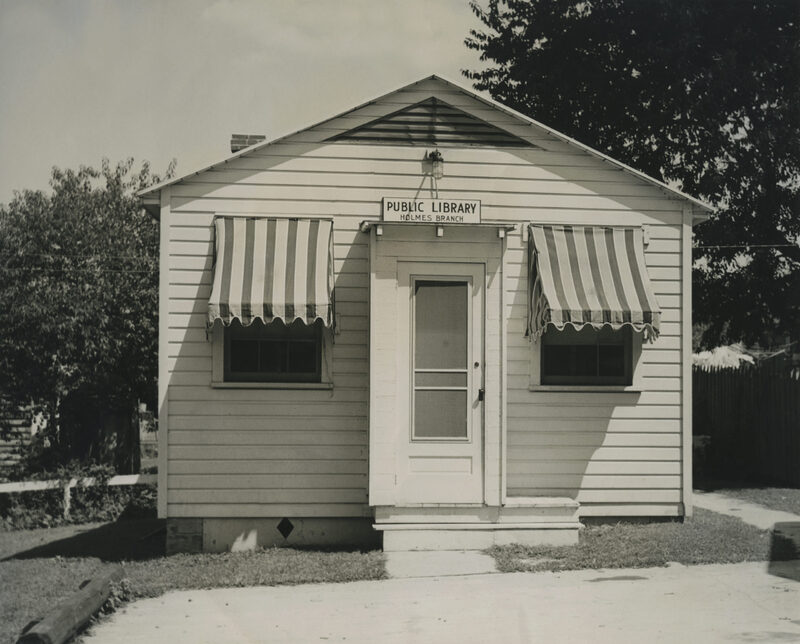More Than Books: The Truth Behind Segregated Libraries in Northern Virginia
By Samuel Huff
In the midst of the Great Depression, the Roosevelt Administration began implementing bold, innovative policies to address the era’s challenges that had cast the tenability of capitalist democracy in a questionable light. One of those initiatives, the Works Progress Administration, would balance the tasks of addressing immediate concerns while also fashioning the administration's vision of a reimagined national identity, one that was more engaged and intellectually competitive on the global stage. Tackleing ubiquitous unemployment and nationally deficient access to educational resources, the WPA provided jobs that would help deliver access to libraries for broad, previously under-served swaths of the population, including many in Northern Virginia.(1) Believing that an educated and informed populace was the best means of buttressing the nation’s economic and political future, the administration hoped the WPA would help propagate civic literacy and national prosperity. (2) In the following decades the number of Americans without access to libraries began to dwindle, but that number increasingly represented one cohort of the population: African Americans.
The segregation that characterized 1940's Virginia was baked into the region's new access to libraries. While some didn’t explicitly outline the exclusion of Black residents in their policies, discriminatory practices still prevailed.(3) As African Americans began asserting their right to utilize the resources of these new spaces of opportunity, libraries either denied them access altogether, established certain "colored" stops for the limited services provided by bookmobiles, or built separate branches to circumvent providing black residents access to the same spaces that white patrons occupied.(4) For most of the 1940s, Black residents of Northern Virginia either had no access to libraries, only had access to bookmobile services or segregated school libraries, or were among the remarkable few that had access to an inferiorly serviced "colored" branch. In 1946, Virginia state law mandated that libraries recieving state-aid provide service to all residents regardless of race, but services to African Americans were still skirted through manipulative interpretations of the law, lackluster enforcement, and outright refusal to comply.(5) As the country began valuing one's ability to educate themselves, African Americans were left with little to no resources to do so; as was so often the case with Jim Crow, the segregation of libraries withheld far more from African Americans than the books in white spaces.
The traditional historical narrative surrounding the segregation of libraries in Northern Virginia aligns with the broader narrative of Jim Crow segregation across the South; while condemnatory, most historical inquiries on the topic obscure the experiences of African Americans by conveying a duality in the segregated environment and limiting the narrative to address physical bodies and material spaces. Indeed the historical terminology associated with Jim Crow often implies an environment of duality, in which black and white spaces are akin to mirror images of one another. Compounded by a perception limited it spatial materiality, the historical narrative fails to address the fundamental nature of the topic, the consequences it produced, and the experiences of those who are often silenced by history.
Recent scholarship has provided more careful and thoughtful analysis. Fairfax librarian, Chris Barbuschak, recently surveyed the evolution of libraries across the region in the 20th century by centering the experiences of black residents in his book, Desegregation in Northern Virginia Libraries. Works like Barbuschak’s are critically important as we move ever closer to a robust understanding of the topic, but there is an exigence in the field of study. When we consider the centrality of space in segregation, we begin to uncover a need to examine the issue with spatial matters at the forefront. In her book, Demonic Grounds, Katherine McKittrick underscores the importance of geography, which she defines as “space, place, and location in their physical materiality and imaginative configurations,” in pursuing black histories.(6) Because traditional, cartographic geographies are defined and distributed by those who hold power, their value lies solely in their capacity to articulate social systems and hierarchies.(7) If we hope to supplant the traditional historical narrative with a more accurate one that empowers black voices, then we must go beyond the books and buildings to engage spaces as living extensions of the people and communities that engaged them.
Our approach will aim to satisfy the exigence by marrying the research and disciplinary strategies of McKittrick and Barbushak as we probe the decade of the 1940s. We will step into the well-traversed topic of segregated libraries but distinguish ourselves with our spatio-philosophic inquiries and our mission to amplify black voices. We will disregard the overly simplistic historical narrative, looking beyond the bricks and books to understand what was really being withheld from African Americans by restricting their access to the same libraries used by white citizens. To determine our answer, we will need to establish the ideological geographies that libraries in general constituted in the perceptions of contemporary white society and African American communities before we finally compare the material and spatial distinctions between segregated libraries
